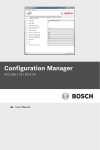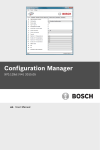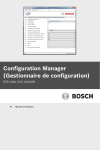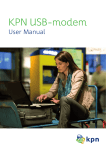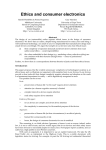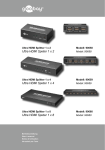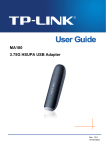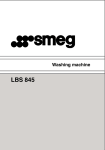Download Telfort USB-Modem User manual
Transcript
Telfort USB-Modem User manual Telfort HSDPA USB-Modem User manual UK v3.0 Page 1 of 29 Contents 1 Modem Introduction.......................................................... 3 1.1 Introduction ............................................................... 3 1.2 Warning and Notice ................................................... 3 1.3 Applicability Scope .................................................... 3 1.4 System requirements................................................ 3 1.5 Functions ................................................................... 3 1.6 Specification .............................................................. 4 1.7 LED indications.......................................................... 4 2 Installation........................................................................ 5 2.1 Outline and Part Introduction ................................... 5 2.2 Hardware Installation................................................ 5 2.3 Software Installation ................................................. 7 2.4 Run the Application Software.................................. 10 2.5 Hardware Uninstall ................................................. 10 2.6 Software Uninstall................................................... 10 3 Functions & Operation .....................................................12 3.1 Interface introduction.............................................. 12 3.1.1 Main Interface .............................................. 12 3.1.2 Description of Mini Icons.............................. 13 3.2 Connecting Internet................................................. 14 3.3 SMS .......................................................................... 16 3.3.1 Read SMS ................................................... 17 3.3.2 Create new message ................................... 18 3.3.3 The SMS box Operating Guide .................... 19 3.4 Addressbook............................................................ 20 3.5 Settings .................................................................... 21 3.5.1 Connection Settings..................................... 22 3.5.2 Security Settings .......................................... 24 3.5.3 Network Settings.......................................... 25 3.5.4 Messages Settings....................................... 26 3.5.5 Alert settings ................................................ 27 3.6 Micro-SD card ......................................................... 27 3.7 Help.......................................................................... 27 4 FAQ & Answers ................................................................28 Telfort HSDPA USB-Modem User manual UK v3.0 Page 2 of 29 1 Modem Introduction 1.1 Introduction Thank you for using Telfort USB-Modem. To guarantee the modem always in its best condition, please read this manual carefully and keep it for further use. The pictures, symbols and contents in this manual are just for your reference. They might not be completely identical with your modem. We operate a policy of continuous development. We reserve the right to update the technical specifications in this document at any time without prior notice. The Telfort USB-Modem is a type of multi-mode, 3G modem, suitable for GSM/GPRS/WCDMA/EDGE/HSDPA network. It adopts USB interface which provides an easy interface to laptop and desktop PC. With the GSM/ GPRS/ EDGE/ WCDMA/ HSDPA mobile network, it can help you carry out SMS, data service and will help you break away from the limit of time and zone, and realize wireless communication at any moment everywhere. 1.2 Warning and Notice To the owner z Some electronic devices are susceptible to electromagnetic interference sent by modem if inadequately shielded, such as electronic system of vehicles. Please consult the manufacturer of the device before using the modem if necessary. z Operating of laptop and desktop PC and modem may interfere with medical devices like hearing aids and pacemakers. Please always keep them more than 20 centimeters away from such medical devices when they are turned on. Turn the modem off if necessary. Consult a physician or the manufacturer of the medical device before using the modem. z Be aware of the usage limitation when using a modem at places such as oil warehouses or chemical factories, where there are explosive gases or explosive products being processed. Therefore, turn off your modem if required. z Don’t touch the inner antenna area if not necessary. Otherwise it will affect your modem’s performance. z Store the modem out of the reach of little children. The modem may cause injury if used as a toy. Modem z Please use original accessories or accessories that are authorized. Using any unauthorized accessories may affect your modem’s performance, and violate related national regulations about telecom terminals. z Avoid using the modem near metallic structure device or establishment that can emit electromagnet wave. Otherwise it may influence receiving signals. z The modem is non-waterproof type, please keep it dry and store in shady and cool place. z Don’t use the modem immediately after a sudden temperature change. In such case, it will produce dew inside and outside the modem, so don’t use it until it becomes dry. z Take the modem carefully. Don’t lose, bend or cause it struck. Otherwise it will lead to destruct damage. z No dismantling by non-professional and only qualified maintainer can undertake repair work. 1.3 Applicability Scope Telfort USB-Modem supports the present mainstream types of laptops and desktop PCs, such as HP, IBM, Toshiba, Lenovo, Dell, Sony, etc. 1.4 System requirements Operating System: Windows 2000 / XP / Vista, and MAC OS X 10.3, 10.4 en 10.5 Configuration (Recommended): CPU 500MHz Pentium or above Hard Disk: 20M or above RAM: 128M or above The performance of the modem may be influenced if configuration is under the recommended requirement. 1.5 Functions Functions: SMS service, data service, applied management, data concurrence, support Micro-SD card, etc. Telfort HSDPA USB-Modem User manual UK v3.0 Page 3 of 29 1.6 Specification Networks Frequency Band Dimension Weight Data Rate Working Voltage Current Loss Max Emission Power Interface type Supported systems Supported operating systems Functions Micro-SD memory card Network standards Frequency bands Temperature HSDPA/UMTS/GSM/GPRS/EDGE HSDPA/UMTS 2100 MHz: 1920 MHz-1980 MHz/2110 MHz-2170 MHz (Up/Down-Link) GSM/GPRS/EDGE 900 MHz: 880 MHz-915 MHz/925 MHz-960 MHz (Up/Down-Link) GSM/GPRS/EDGE 1800 MHz: 1710 MHz-1785 MHz/1805 MHz-1880 MHz (Up/Down-Link) GSM/GPRS/EDGE 1900 MHz: 1850 MHz-1910 MHz/1930 MHz-1990 MHz (Up/Down-Link) 82mm x 28mm x 12mm 55g In HSDPA Mode, max download speed 7.2Mbps In UMTS Mode, max speed 384 Kbps In EDGE mode,max speed 236.8Kbps 5V(Using the laptop or desktop PC power supply) Average: 500mA In 3G WCDMA Mode: 250mW In 2G GSM/GPRS Mode: 2W USB standard (1.0 and 2.0) Support for the most laptops en desktop PC’s Windows 2000, XP SP2, Vista Apple MAC OS X 10.3, 10.4, 10.5 SMS service, data service, internet, applied management, data concurrence, support Micro-SD card Support up to 4GB memory capacity HSDPA/UMTS/EDGE/GPRS/GSM HSDPA/UMTS 2100MHz, GSM/GPRS/EDGE 900/1800/1900MHz -20ºC ~ +60ºC 1.7 LED indications In the USB-Modem there is a multi-colour-LED (light), which shows the status of the modem, using different colours and flash-signalling. In this table below an explanation is given of all different situations: LED indication USB-Modem working status Red Error Status, or Modem not ready yet, busy starting up Green blinking Attached to GPRS or EDGE network Green burning Active connection via GPRS or EDGE network Purple blinking Attached to UMTS or HSDPA network Purple burning Active connection via UMTS network Blue burning Active connection via HSDPA network Light-Blue burning Micro-SD memory-card found and ready to use Telfort HSDPA USB-Modem User manual UK v3.0 Page 4 of 29 2 Installation 2.1 Outline and Part Introduction 1. USIM/SIM Card Slot 2. Micro-SD Card Slot 3. USB Port 4. Modem Cover 2 1 3 4 2.2 Hardware Installation 1. Insert the SIM/USIM card into the USB-Modem: First, you should insert your SIM/USIM card into the USB-Modem, and confirm that your SIM/USIM card support data service, Internet, UMTS and HSDPA etc. If you have questions on this, please consult the shop or Telfort help desk. To install SIM/USIM card, first take down the modem cover, then the USB connector is visible. . Pull the plastic socket above the USB connector a little out. Telfort HSDPA USB-Modem User manual UK v3.0 Page 5 of 29 Then insert the SIM/USIM card as deep as possible into the socket, here make sure that metal contact facing to the modem. Please refer to the following picture, insert the SIM/USIM card smoothly into the modem, with the cutted edge into the stick. Insert the (U)SIM so deep into the modem that it falls completely within the housing of the modem, and let the small plastic socket give a small click to fall into the right position. 2. Install memory card Even more you can do with this modem, you can use a compatible Micro-SD card to save more data. Only Micro-SD card is supported by the modem and do not use other memory card in the modem. Install Micro-SD memory-card in the USB-Modem, if you want to use it. Open the Micro-SD card cover. Insert the Micro-SD card into the slot. Make sure the metal contact side of the memory card facing the modem shown as the following picture. Then close the Micro-SD card slot cover. The driver of the Micro-SD card will installed automatically when the modem driver is installed. Note: maximum 4GB Micro-SD card is supported 3. Connect the USB-Modem to your PC: z Then connect the USB-Modem to the USB port and ensure that it is tightly inserted. z The modem will be automatically recognized. z The system will automatically detect and recognize the new hardware and display the new icon in the desktop status bar, indicating that the computer and the USB-Modem have been connected properly. After a few seconds, the installation program will start automatically. Telfort HSDPA USB-Modem User manual UK v3.0 Page 6 of 29 2.3 Software Installation The system will automatically detect and recognize the new hardware and display the new icon in the desktop status bar, indicating that the computer and the USB-Modem have been connected properly. After a few seconds, there will show the following installation interface if the laptop and desktop PC supports automatic installation. If the laptop and desktop PC doesn’t support automatic installation, start the installation program by run the AutoRun.exe from the CD-ROM drive. The following installation interface will show how to start installation. Select the language according to the operating system and click “Next”, and then you will see the following screen will popup: Choose the language then click OK, the following screen will shows up: Strongly recommend you to exit “Windows” programs, and click “Next”; Telfort HSDPA USB-Modem User manual UK v3.0 Page 7 of 29 Read the agreement carefully. If you agree, choose “I accept the terms of the license agreement”, and then click “Next”. Select the folder that you want to install the software, and you can select a different path by pressing “Change”, then click “Next”. Telfort HSDPA USB-Modem User manual UK v3.0 Page 8 of 29 The dashboard software “Telfort Mobile Connect” begins to install. The system show the installation progress, wait a minute and the following screen will shows up: Click “Finish” to complete the installation. Telfort HSDPA USB-Modem User manual UK v3.0 Page 9 of 29 Note:If you have problems with installation after the upper operation, please contact the shop or the Telfort help desk. After the installation, select the “Start → Programs” and there will be a “Telfort Mobile Connect” program group,which includes “Telfort Mobile Connect” and “Uninstall”. There will be a Shortcut icon like below on the desktop. 2.4 Run the Application Software After the modem is correctly connected, click the “Start → Programs → Telfort Mobile Connect → Telfort Mobile Connect” menu on the laptop and desktop PC to run the application software. Or double click the shortcut icon, to run the following application software. After modem initialized, main interface appears. When the standby icon appears in the taskbar, the modem can work properly. 2.5 Hardware Uninstall Close the software application then remove the hardware following the procedure below. on the interface and then click “OK” to close the software. - Firstly click the close button - For example in Windows XP, right click the icon from windows taskbar, the following menu shows: Now you can safely remove your USB-Modem When you use a Micro-SD card in the modem, please left click the menu will popup and indicates the USB devices list as below: icon in the Windows system tray bar. Then a Select “Safely remove the USB disk” which is relevant to the Micro-SD card. Pull it off the USB cable directly, if you want to disconnect the modem from the laptop and desktop PC. Then you can pull the USB stick out from the laptop or desktop PC USB slot. 2.6 Software Uninstall Close the application program before the software uninstalls. Click “Start→ Programs →Telfort Mobile Connect→ Uninstall” menu on the laptop or desktop PC. Click “Yes” to confirm uninstall of the software. Telfort HSDPA USB-Modem User manual UK v3.0 Page 10 of 29 Click “Yes” according to the indication, then the system begins to uninstall programs, This interface will indicates the progress of uninstall. When uninstall finish, the ‘Uninstall Complete” interface will popup. Click “Finish” to restart the computer and complete the application software uninstall. Telfort HSDPA USB-Modem User manual UK v3.0 Page 11 of 29 3 Functions & Operation 3.1 Interface introduction 3.1.1 Main Interface The starting screen of the USB-Modem dashboard software is shown as the following: Function area System information area User area The whole interface is divided into three parts; related functions can be executed by operation in the related areas. 1. Function button area: There will show various function button icons. Select different function button and it will carry out corresponding operation. Status Connection: Connect to the Internet. SMS: Send SMS or read SMS. Addressbook: Save and view the different information of the contact list. Settings: Set normal relative information for the modem. Micro-SD: Quick link to the Micro-SD card. Help: System information for Help. 2. System information area: Show the system status and different kinds of tips. The icon indicates the network signal intensity. There are 6 stages from none strongest to the . The icon indicates there are new SMS at present. The icon indicates the current status of Internet connection is not connected. The icon indicates the current status of Internet connection is already connected. The letter “ P” means it supports packet-switch (P)service, while letter “ C” means it supports circuit Telfort HSDPA USB-Modem User manual UK v3.0 Page 12 of 29 switch(C)service. “P” is necessary for Internet connection. The icon indicates insert status of the modem. Green means it has been inserted into the computer. The icon indicates insert status of the modem. Red means it has not been inserted into the computer. The icon indicates insert status of the modem. in offline status. Yellow means it has been inserted into the computer but The icon indicates insert status of the SIM/USIM card to the modem. Green means the card has been inserted. The icon indicates insert status of the SIM/USIM card to the modem. Red means it has not been inserted. The icon indicates the current network type, i.e. EDGE or GPRS, HSDPA service. This icon indicates the name of the current service supplier. This icon is various by different supplier. 3. User Area: Show the man-computer interaction information under various conditions. 3.1.2 Description of Mini Icons When click the mini button, the software will minimize as an icon on the system tray. If connected to the Internet, the minimized software won’t influence the download of data or receiving SMS. When the application window is minimized, the system icons will display on the taskbar. Double click the icon to resize the display. Taskbar Icons Description: The USB-Modem has been inserted into the computer. The USB-Modem not been inserted into the computer. The USB-Modem is offline. SIM/USIM card has not been inserted. No network signal. There is a new message. The USB-Modem is ready to connect to Internet. The Internet connected is connected. The uses of Tray Icons: Right Click the tray icons, the following menu will appear: Power off Modem: by closing the dashboard software, you can power off and disconnected the USB modem; only after you power off your USB modem, you can safely remove the USB modem from your laptop or desktop PC. Modem is Off-line/Modem is On-line: Disconnect the current connection of the modem and the network. After this action the modem will be disconnected from the network. Factory Settings: Restore some of the settings to the original values. Help: Enter the interface of Help. About: View the information of the application software and hardware versions. Exit: Close the software and stop the modem from working. Telfort HSDPA USB-Modem User manual UK v3.0 Page 13 of 29 3.2 Connecting Internet You can browse web pages after you have accessed to Internet with the help of modem, you can also receive SMS when surfing in the Internet. Connect to the Internet: Click the Status Connection icon “Connect”. . Then the system will ask you “Connect to Telfort Internet?” Select When connected, it will show “State: connected to …”, and it will show data amount, connected time and so on. Then you can access Internet and receive email etc through network. Telfort HSDPA USB-Modem User manual UK v3.0 Page 14 of 29 During the course of connecting, when the “Connect” 'button becomes “Disconnect” button, you click “Disconnect” to cancel the connecting. Note: The modem has the function of locking the SIM/USIM card. If you use the SIM/USIM card provided by the other network provider, maybe you can’t connect to the network. If you have any problem, you can consult your network provider for further information. Internet connection records: Click “Internet connection records” to check the Telfort HSDPA USB-Modem User manual UK v3.0 log of Internet connection history. Page 15 of 29 3.3 SMS Note: To ensure that the SMS can be used properly, at first, you should setup the correct SMS center number. Refer to section “ 3.5.4 Messages settings”. Click the “SMS” icon to switch to the SMS interface and it will show the number of SMS in the inbox, outbox and draft box. The user can click icons of “InBox”, “OutBox”, “DraftBox” and “New Message” to enter relative interface. Telfort HSDPA USB-Modem User manual UK v3.0 Page 16 of 29 InBox: Save the received SMS. OutBox: Save the successfully sent SMS. Draft box: Save the editing SMS which haven’t been sent. The drafts can only be saved in PC side. New Messages: Write a new message. For example: “Message in InBox PC : 2 Item(s) (U)SIM Card: 1 Item(s)” means: The PC side has 2 short message and there are 1 short messages in the Inbox of the SIM card , “SIM Card capability” means the SIM card can hold 30 short messages. Different SIM/USIM cards will have different capacities. For more information, please consult your supplier. It will show the capacity automatically in usage, like the above “30”. 3.3.1 Read SMS Click the “Inbox” button or the SMS icon on the system information area to read the SMS saved in the box. . You can use the buttons under the menu to execute reading, replying, forwarding, move, delete, saving numbers functions and so on. Telfort HSDPA USB-Modem User manual UK v3.0 Page 17 of 29 3.3.2 Create new message Click “New Message” button to input the recipient’s number and content. Telfort HSDPA USB-Modem User manual UK v3.0 Page 18 of 29 The recipient’s number can be input directly or by entering the Addressbook to select one/more/group records. The recipient’s amount can be one or more. Please use “;” to separate recipients. The SMS content can include 140 individual English characters (including English symbols. On the interface, there will show total characters. Click “Send”, the prompt screen like bellow will appear on the interface. Select “Yes”, and then the edited short messages will be sent. After sent successfully, the SMS will be saved into outbox automatically. If send fails, it will be saved to the draft box automatically. Send SMS while browse the web: When surfing the Internet, if your network supports, you can send short messages. Click “SMS” button icon, enter the short message interface to send short messages normally. 3.3.3 The SMS box Operating Guide Enter any of the InBox/OutBox/DraftBox to execute the following functions: Read: Read all the information of short messages. (The content of short messages, sender’s phone number, delivered date and time) Reply: Reply short messages to the sender. Forward: Send the short message to other recipients. Move: Change the saved position (at PC side or USIM/SIM card) of short messages to another position (at USM/SIM card or PC side). When the modem receives new short messages, it will receive them by the USIM/SIM card and save them at Telfort HSDPA USB-Modem User manual UK v3.0 Page 19 of 29 the PC side. Delete: Delete the selected short messages. Save: Save the send part number obtained from the message to Addressbook. Cancel: Return to the SMS interface. If you want to select several messages, you can use the “Ctrl” or “Shift” key to execute multi-choice, and left click an item to add to selection. New message can not be received when the USIM/SIM card is full of short messages (Different USIM/SIM cards have different capacities), the system will indicate the inbox is full and make users clear the inbox at USIM/SIM card side, while new message can not be saved. 3.4 Addressbook Click the “Addressbook” icon to switch to the Addressbook interface, the Addressbook information can be saved in the PC or SIM/USIM card and you can choose the saved position. Each record includes contact name, mobile phone number, family phone number, office phone number, email and the group name which it belongs to. 1. New Contact: Left click “New” →”New Contact”, input the content, then select “OK” to finish adding a new contact. 2. New Group: You can add new group at the PC side. But you cannot add new group at the SIM side. Left click the “New” →”New Group” and input the group name, Select contact records from the right contact list and drag them to the right group item, if you want to add contacts to a group. 3. Other buttons Description If any contact is selected, you can carry out the following steps: Telfort HSDPA USB-Modem User manual UK v3.0 Page 20 of 29 View: View the selected contact’s information. Delete: Delete contacts or groups. SMS: Send messages to the mobile phone numbers in the records. Save as: Save the detail information of the selected contacts to a TXT file on local drive. Edit: Edit the information of selected contact. 3.5 Settings Click “Settings” icon to switch to the settings interface. It includes: Connection settings, Security settings, Network settings, Messages settings, Alert settings. Note: all the necessary settings have been correctly saved in your USB modem by Hi, there is no need to change such settings. Telfort HSDPA USB-Modem User manual UK v3.0 Page 21 of 29 3.5.1 Connection Settings To ensure that the modem can connect the Internet properly, you should configure the connection information first. 1. Button description Add: Add new configuration files. Delete: Delete the selected configuration files. Edit: Edit the selected configuration files. Set Default: Select one configuration file from the list, and set it as the current using files. Telfort HSDPA USB-Modem User manual UK v3.0 Page 22 of 29 2. Config File Select “add” to add new connection information to the system. The “Config File” screen wills popup: The configuration information includes: Config Filename, Dial Number, User name, Password, APN, DNS, and PDP address. If network supports “Obtain server address automatically”, the modem can obtain the assigned IP information automatically. If network does not support it, you should input the proper address manually. Please consult the network supplier of SIM/USIM card for all above information. The configuration information may be various according to the different network suppliers and network types. Telfort HSDPA USB-Modem User manual UK v3.0 Page 23 of 29 3.5.2 Security Settings 1. Enable the PIN Code: When “PIN enable” item is selected, please enter PIN code to use the modem and you can click “Revise PIN” to modify the number. 2. Backup Addressbook and SMS: If the item is selected, it means that the Addressbook and SMS will be backup manually in the PC side. If you operate the data by mistake, you can click the “Resume” to restore to the previous data. Telfort HSDPA USB-Modem User manual UK v3.0 Page 24 of 29 3.5.3 Network Settings 1. Select Network: Automatic: The system selects the network automatically by the user’s selected rules and the network status. Manual: The network is selected by users themselves. 2. Network Mode Select Automatic: The system selects the available network automatically. UMTS Only: The system will only select the UMTS network. GSM Only: The system will only select the GSM network. 3. Manual Select When the “Manual” is selected, click the “Apply” button, pop-up the following window: Wait about 2 minutes, the supplier list will show in the windows and which with the green icon can be selected. Select a proper network to connect. Telfort HSDPA USB-Modem User manual UK v3.0 Page 25 of 29 Select the network that the supplier is utilized and press “Select” to enter the network. 3.5.4 Messages Settings Telfort HSDPA USB-Modem User manual UK v3.0 Page 26 of 29 Message Center: Set the corresponding SMS center number via the SIM/USIM card of the supplier. You must input the correct SMS center number to use the SMS properly and the number will be provided by the network supplier. Please enter the country code before the number. Telfort SMS center number is +31653131313. Validity period: Set the time limit for saving SMS in the network side. (This function needs network supports.)In option:12 hours/A day/A week/The longest period. Standard setting is the longest period permitted by the network. Location of Saving New SMS: Select “Default” to save in location set by network. Select “(U)SIM Card” to save in SIM/USIM card; select “PC” to save in PC. 3.5.5 Alert settings You can set “Connection alert, Disconnect alert and Incoming SMS alert” by yourself. These alerts will sound on the PC side. The audio file supports MP3、WAV and MIDI format. If you select “Mute”, you cannot hear corresponding alert. 3.6 Micro-SD card Click “Micro-SD” icon and then the system will lead you to the directory of the Micro-SD card in the USB-Modem. It is convenient for you to check the contents in your Micro-SD card. 3.7 Help Click “Help” icon , and switch to the help interface. Under the help topic, you can get the USB-Modem information about function introductions, installation and usage guide, visions and published date of application software and hardware, etc. Telfort HSDPA USB-Modem User manual UK v3.0 Page 27 of 29 4 FAQ & Answers When you meet the following problems in service, please refer to the following answers to solve it. If the problems still exist, please contact with your suppliers. Problem Description The system can not run the installation program automatically. Possible Causes The system configuration is not suitable for the auto run. After the full installation, the system doesn’t install the driver program properly. The system configuration is not suitable for the auto run. After the modem is plugged in, the UI program doesn’t run automatically. After restarted the computer, there is no signal. The system configuration is not proper. When the USB-Modem has been plugged in, computer cannot find the visual disc of the USB-Modem. Message sent failed. Date connection failed. 1 The position of the USB-Modem inner antenna is unfitting. 2 You are in the place where no GSM/GPRS/EDGE/WCDMA/HSDP A network covered , such as underground parking lot, tunnel etc. 2 Change to the places where there is good signal. 1 The installation programs of the USB-Modem haven’t been installed properly. 1 Run the installation program first, then insert the modem. If you use the WinXP operating system, install the drivers according to the Windows indication information to operate. 2 The modem isn’t inserted well. 2 Restart the computer, or insert the modem again. 3 The SIM/USIM card isn’t inserted well, such as inserted in reverse. 3 Insert the SIM/USIM card correctly again. Make sure the metal contact side should be inserted inside 1 After consulted with service provider, configure the right number in Message settings. 2 Try later. 1 The SMS center number isn’t correct. 2 The network is busy and other reasons. 1 You are in the place where no GSM/GPRS/EDGE/WCDMA/HSDP A network covered,such as underground parking lot, tunnel etc. 2 The network at this time in this place is busy now. Telfort HSDPA USB-Modem User manual UK v3.0 Problem Solving Open the visual disc of the modem program and start the autorun.exe. If you have installed the other version of installation program please uninstall it firstly. Please install the driver program manually. The driver program can be found in the installation address: C:\Program Files\Telfort Mobile Connect\drivers Please open the UI program manually. You can find it in the Start→ Program menu or the shortcut on the desktop. 1 Adjust the angle and position of the USB-Modem. 1 Change to the place where there is good signal. 2 Try later. Page 28 of 29 Problem Description Possible Causes 3 The APN in the configuration files is error. 4 The modem data is error. 5 The network type selected by manual is wrong. Connected to the Internet, but it cannot open any website page. 1 After connection, there is no data transfer, which resulted that you can not open web pages. 2 The IE browser got problems. 3 The operating system is infected by virus (Such as Worm Blaster which can take up a quantity of upload data flow and result that it can’t receive downloaded data flow so that you cannot open any website.) 4 You have connected to other APN. which cannot connect to the Internet. The Modem cannot connect to the Internet in other places No warning tone My Micro-SD memory-card can not read or not found Telfort HSDPA USB-Modem User manual UK v3.0 Your USB-Modem is not permitted to roam in your network. No audio card is fixed in computer or the volume is too small. Check the Micro-SD card capacity, the maximum supported capacity is 4GB Problem Solving 3 Check the APN in the configuration file in the “Connection settings”. For Telfort the APN is fastinternet. 4 It is perhaps the GPRS or WCDMA network problem and please contact with the local supplier in time. 5 Select the correct network type according to the type of the SIM/USIM card. 1 Check that the APN in the Configuration files is correct or not. 2 If the IE gets problems, upgrade to the new version or reinstall the IE browser. 3 Use the professional anti-virus software to check and kill the virus in the operating system completely. 4 Consult the shop or Telfort helpdesk. Connect with the shop or Telfort helpdesk. Check the audio card and adjust the volume properly. Use another Micro-SD card with a maximum capacity of 4GB Page 29 of 29





























